Maintaining hygiene is crucial in preventing the spread of germs and illnesses. Germs and bacteria are microscopic organisms that cause infections and are present everywhere, from our bodies to our surroundings. Keeping ourselves and our environment clean is essential to maintaining good health. This is where sterilization and disinfection play pivotal roles. Despite their importance, these are often used interchangeably, leading to considerable confusion for many.

This article will explore the difference between sterilization and disinfection, helping you make informed decisions about maintaining hygiene in different settings. Which method is best for your needs? How do you effectively employ each technique? What are the benefits and limitations of sterilization and disinfection? You’ll find more answers to these questions as you delve deeper into this piece.
Disinfection and Sterilization
Disinfection and sterilization are the two prevalent methods used to kill or inhibit the growth of harmful microorganisms, thereby minimising their detrimental effects on health and safety. These microbes can be responsible for causing numerous diseases in both humans and animals, as well as contributing to food spoilage. While both methods aim to reduce the presence of pathogens, they work through distinct mechanisms and are appropriate for different environments and applications.
Understanding the fundamental differences between sterilization and disinfection is key to effectively employing these methods in the right situations to enhance overall health and safety. Let’s dive deeper into the specifics of each process to build a clearer picture.
Disinfection
Disinfection is the process that aims to reduce the number of microorganisms on any surface to a safe level. While it does not necessarily eliminate all microbes, disinfection significantly lowers the risk of infection by minimising germ populations.
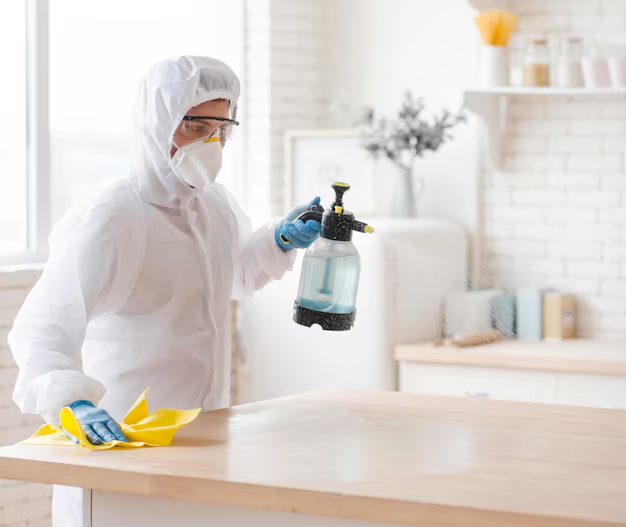
One of the most common applications of disinfection is in the daily cleaning of surfaces. This includes:
- Safely disinfecting kitchen and bathroom countertops reduces the risk of contamination from food, personal care products, and general use.
- Regular cleaning of common surfaces like doorknobs, light switches, and handles helps prevent the spread of germs and bacteria from frequent contact.
- School areas such as classrooms, cafeterias, and playgrounds are regularly disinfected to minimise the spread of illness among students and staff.
- Gyms’ fitness equipment, locker rooms, and high-touch areas are frequently cleaned to ensure a safe space for exercise.
- Public transportation like buses, trains, and stations undergo regular disinfection to reduce the transmission of pathogens among passengers.
- Regular disinfection of hospital rooms, including beds, tables, and medical devices, helps maintain a sterile environment.
- Strict disinfection protocols are followed to prepare operating rooms for surgery, ensuring a germ-free area for procedures.
- Restaurants and cafeterias kitchens, food preparation surfaces, and dining areas are regularly disinfected to maintain hygiene standards.
- Food processing plant equipment, storage areas, and transport containers are routinely disinfected to prevent foodborne illnesses.
- Regular cleaning of desks, workstations, keyboards, and phones helps reduce bacteria and viruses in office settings.
- Common areas like restrooms, conference rooms, and break rooms are frequently disinfected to ensure a healthy workspace.
Visit the Total Cleanz website to discover more about our full range of Disinfection Services in Singapore.
Sterilization
Sterilization is a method that goes a step further by eliminating all forms of microbial life, including spores, bacteria, viruses and even fungi. This stringent level of cleanliness is indispensable in specific environments to prevent infections and ensure safety. Here’s why sterilization is crucial in various settings:
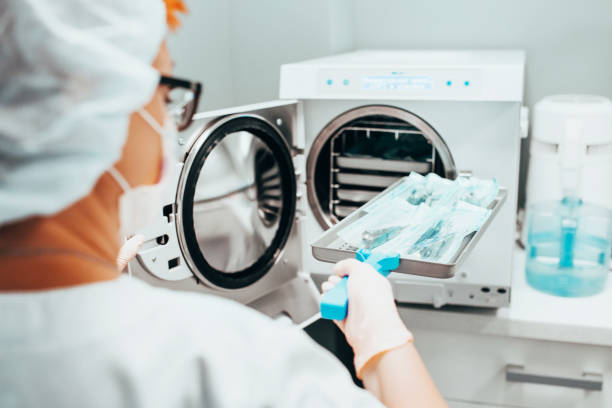
In medical facilities, sterilization can be used in surgical instruments, implants, and other invasive devices that must be entirely free of pathogens to prevent infections during medical procedures. For instance, in surgeries, even simple contamination can lead to severe postoperative infections, potentially causing prolonged hospital stays or life-threatening complications. Therefore, autoclaving (high-pressure steam) is commonly used to ensure that medical instruments are sterile before any procedure.
Laboratories, especially those conducting microbiological or biomedical research, require an aseptic environment to avoid contamination of experiments. Sterilization ensures that the presence of microorganisms does not compromise experimental results. This cleanliness is often achieved through autoclaves or chemical sterilants that eradicate all potential contaminants, maintaining the integrity of scientific findings.
Sterilization is also highly needed in industries such as food and pharmaceutical production. For instance, medical equipment used to manufacture drugs must be entirely sterile in the pharmaceutical industry to prevent contamination that could alter the drug’s efficacy or safety. Similarly, sterilization helps extend shelf life in food processing and ensures products are safe for consumption. Techniques like pasteurisation (heat/steam treatment) or using ethylene oxide gas are commonly used.
Several methods can achieve sterilization, including dry-heat sterilisers, ionising radiation, special chemicals, and vapourised hydrogen peroxide. Each is suited to different materials and purposes. These methods remove all bacteria and viruses, providing the highest level of microbial control.
How to Choose the Right Cleaning Method: Sterilization or Disinfection
Let’s delve into the key differences between sterilization and disinfection to help you decide which method is best for a particular situation.

A good rule of thumb for choosing the right method is:
☑️ Use sterilization when completely eliminating all germs is necessary, such as in medical procedures or scientific research.
☑️ Disinfection is sufficient for everyday cleaning and reducing the risk of infection in homes, businesses, and public spaces.
What are the advantages and disadvantages of sterilization?
Advantages:
Ensures total elimination of all microorganisms
Essential for medical and laboratory environments
Provides the highest level of microbial control
Disadvantages:
It can be harsher on materials, potentially damaging delicate instruments
It may not be practical or cost-effective for everyday cleaning
Some methods require specialised equipment and training
What are the advantages and disadvantages of disinfection?
Advantages:
More practical and cost-effective for routine cleaning and disinfection
Many disinfectants are readily available and easy to use
Disadvantages:
Does not kill all harmful microbes or bacterial spores
Regular application is needed to maintain a low level of germs
Factors like the type and level of contaminants, temperature, and organic matter can influence effectiveness
Here’s a quick view of the key differences between sterilization and disinfection:
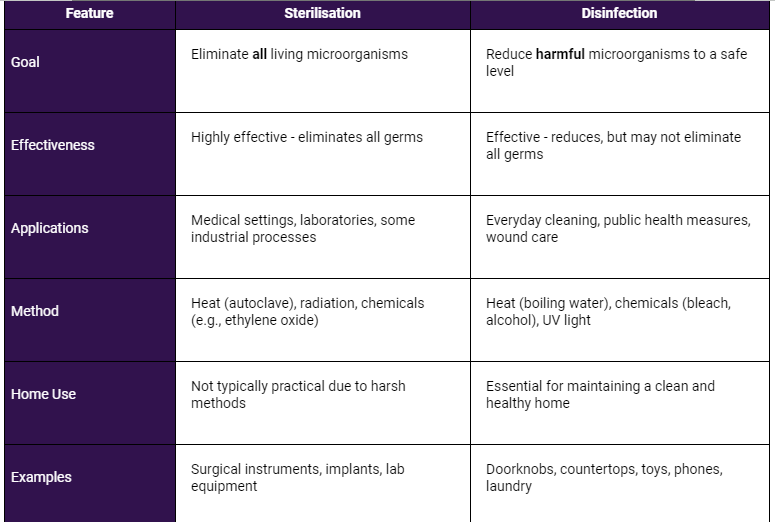
By understanding the differences, you can decide whether to use sterilization or disinfection for your needs.
Disinfection Methods for a Healthy Home or Business
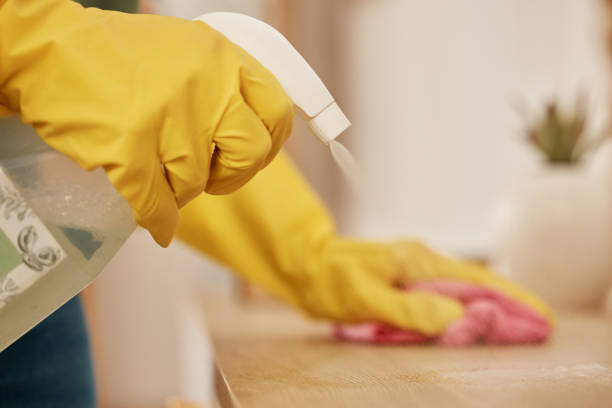
Regularly disinfecting your home or business environment is vital for maintaining good hygiene. Here are some common disinfection methods:
Diluted bleach solutions are effective chemical disinfectants for many surfaces. However, it’s crucial to follow proper ratios and the mixing of bleach with other disinfecting agents.
Alcohol wipes are convenient for disinfecting small surfaces and are particularly useful for electronic devices and personal items.
When using disinfectants, it’s important to follow safety guidelines:
Always follow the manufacturer’s instructions for dilution and application.
Wear appropriate protective equipment like eye protection and gloves.
Ensure adequate ventilation to avoid inhaling chemical fumes.
Store disinfectants safely.
Remember: Chemical disinfection is most effective after thorough cleaning and sanitising. Cleaning physically removes dirt and debris, while sanitising reduces germs safely. Disinfection adds an extra layer of protection by targeting and eliminating harmful pathogens.
Conclusion
In summary, sterilization and disinfection are valuable tools in our fight against microorganisms. Sterilization eliminates all microbes, while disinfection significantly reduces their numbers. Understanding these important differences empowers you to choose the right method for your needs. By implementing appropriate sterilization or disinfection practices, you can better protect your health and ensure a safer environment for everyone.





